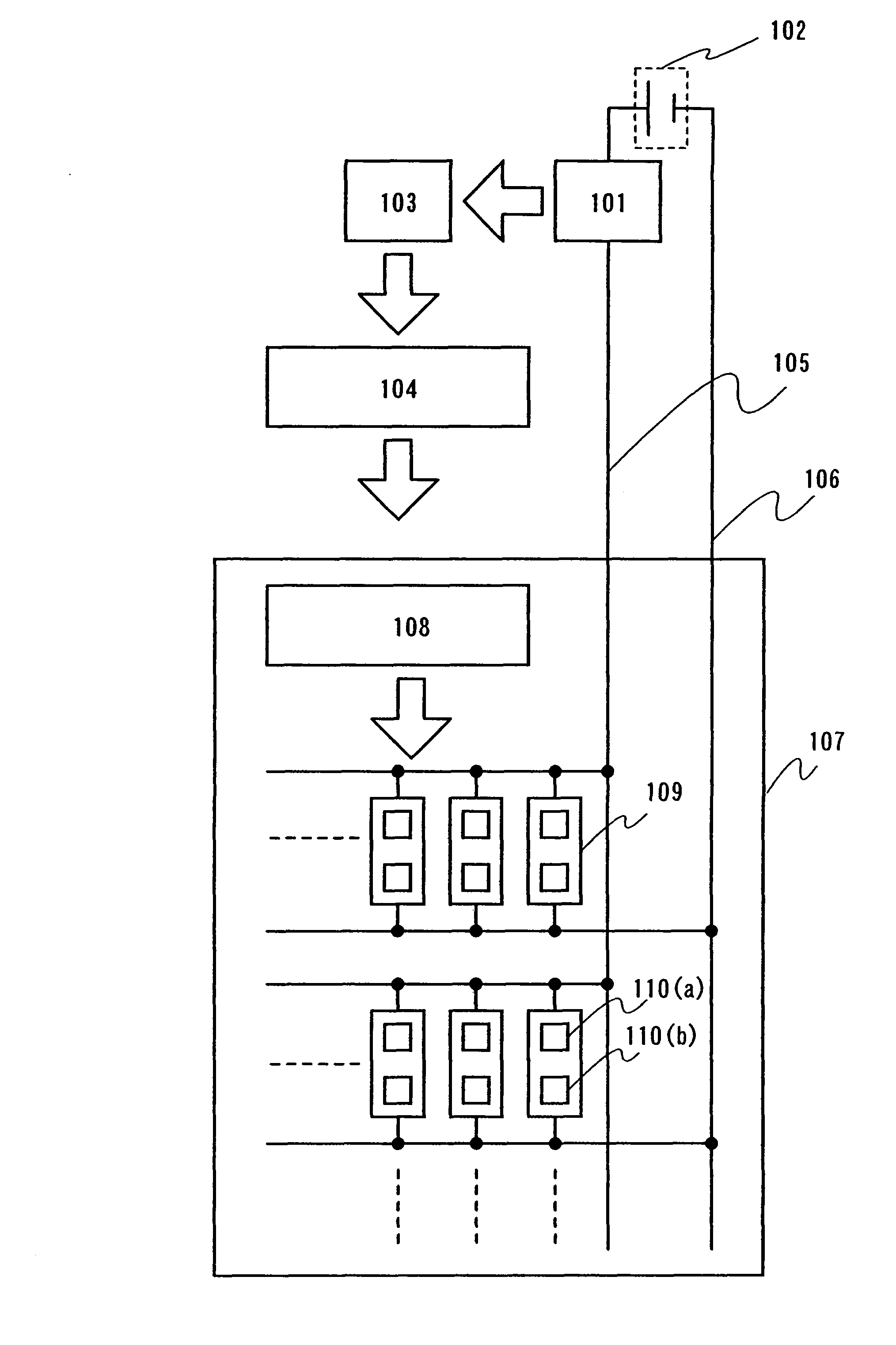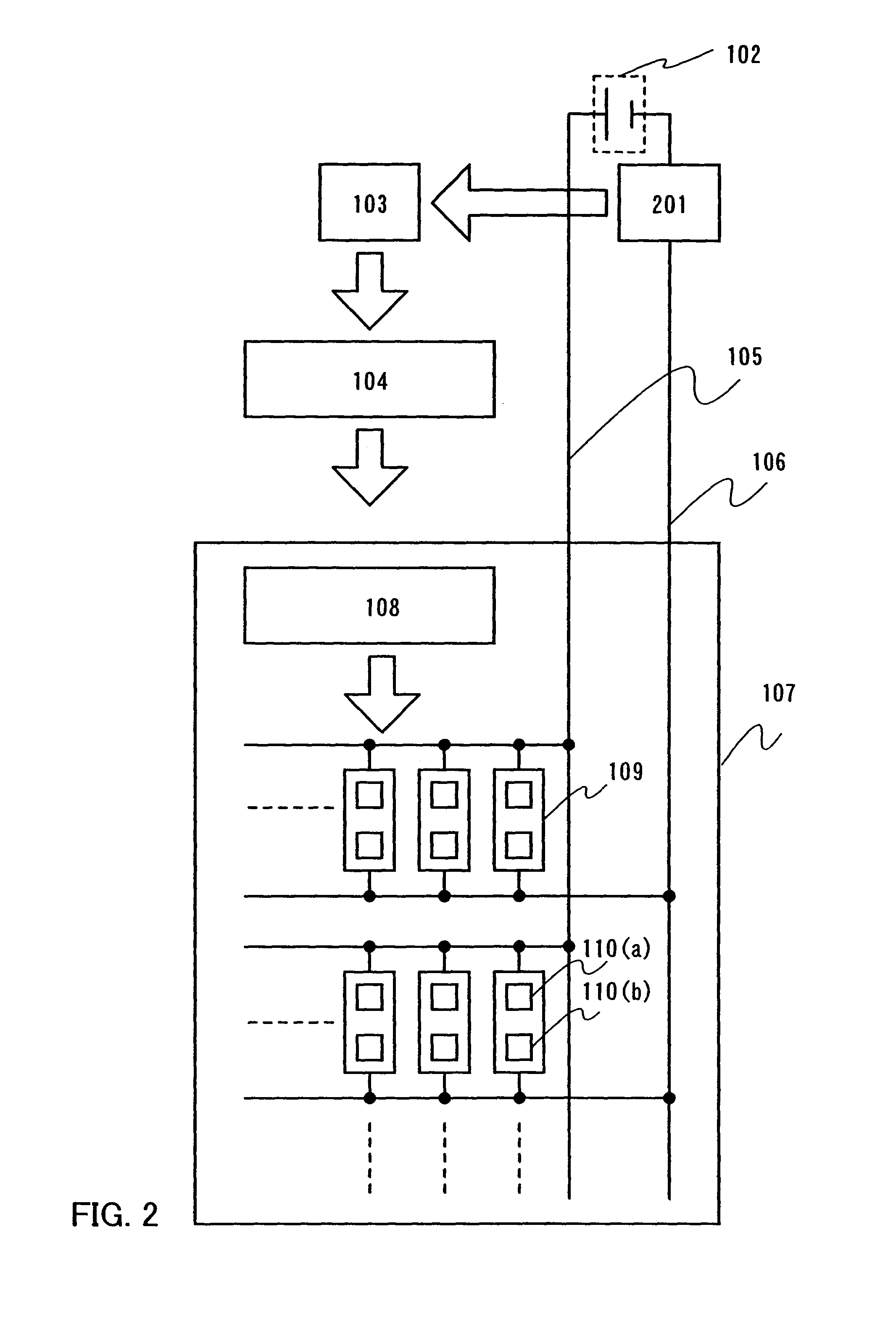Semiconductor device and driving method thereof
a technology of magnetic field and driving method, which is applied in the direction of static indicating devices, non-linear optics, instruments, etc., can solve the problems of low yield and inability to take particular measures, and achieve the effects of improving the reliability of transistors, reducing off-current, and reducing the number of transistors
- Summary
- Abstract
- Description
- Claims
- Application Information
AI Technical Summary
Benefits of technology
Problems solved by technology
Method used
Image
Examples
embodiment mode 1
[0103] Description will be made of a display device with a first configuration, with reference to FIG. 1. In FIG. 1, reference numeral 101 denotes a current value detection circuit, 102 denotes a power supply, 103 denotes a compensation circuit, 104 denotes a signal input circuit, 105 denotes a power supply line, 106 denotes a wire, 107 denotes a panel, 108 denotes a driver circuit, 109 denotes a pixel, and 110(a) and 110(b) denote sub-pixels.
[0104] In this semiconductor device, the power supply line 105 is connected to the sub-pixels 110(a) and 110(b) which constitute the pixel 109; the wire 106 is connected to the sub-pixels 110(a) and 110(b) which constitute the pixel 109; the power supply line 105 is connected to a positive side of the power supply 102 through the current value detection circuit 101; a negative side of the power supply 102 is connected to the wire 106; the current value detection circuit 101 outputs a current detected to the compensation circuit 103; the compen...
embodiment mode 2
[0121] Description will be made of a display device with a second configuration, with reference to FIG. 2. In FIG. 2, reference numeral 201 denotes a current value detection circuit, 102 denotes a power supply, 103 denotes a compensation circuit, 104 denotes a signal input circuit, 105 denotes a power supply line, 106 denotes a wire, 107 denotes a panel, 108 denotes a driver circuit, 109 denotes a pixel, and 110(a) and 110(b) are sub-pixels.
[0122] In this semiconductor device, the power supply 102 is connected to the sub-pixels 110(a) and 110(b) which constitute the pixel 109; the wire 106 is connected to the sub-pixels 110(a) and 110(b) which constitute the pixel 109; the power supply line 105 is connected to a positive side of the power supply 102; a negative side of the power supply 102 is connected to the wire 106 through the current value detection circuit 201; the current value detection circuit 201 outputs a current detected to the compensation circuit 103; the compensation ...
embodiment mode 3
[0136] Description will be made of an exemplary configuration of the current value detection circuits 101 and 201 described in Embodiment Modes 1 and 2, with reference to FIG. 3.
[0137] In FIG. 3, reference numerals 301 and 302 denote power supply lines, 303 denotes a resistor, 304 denotes a switching element, and 305 denotes an analog-digital converter circuit.
[0138] In this semiconductor device, the power supply line 301 is connected to one terminal of the resistor 303 and one terminal of the switching element 304. The power supply line 302 is connected to the other terminal of the resistor 303, the other terminal of the switching element 304, and an input of the analog-digital converter circuit 305. In addition, the power supply line 301 is connected to the positive side of the power supply 102 (in Embodiment Mode 1) or the negative side thereof (in Embodiment Mode 2), while the power supply line 302 is connected to the power supply line 105 (in Embodiment Mode 1) or the wire 10...
PUM
 Login to View More
Login to View More Abstract
Description
Claims
Application Information
 Login to View More
Login to View More - R&D
- Intellectual Property
- Life Sciences
- Materials
- Tech Scout
- Unparalleled Data Quality
- Higher Quality Content
- 60% Fewer Hallucinations
Browse by: Latest US Patents, China's latest patents, Technical Efficacy Thesaurus, Application Domain, Technology Topic, Popular Technical Reports.
© 2025 PatSnap. All rights reserved.Legal|Privacy policy|Modern Slavery Act Transparency Statement|Sitemap|About US| Contact US: help@patsnap.com



